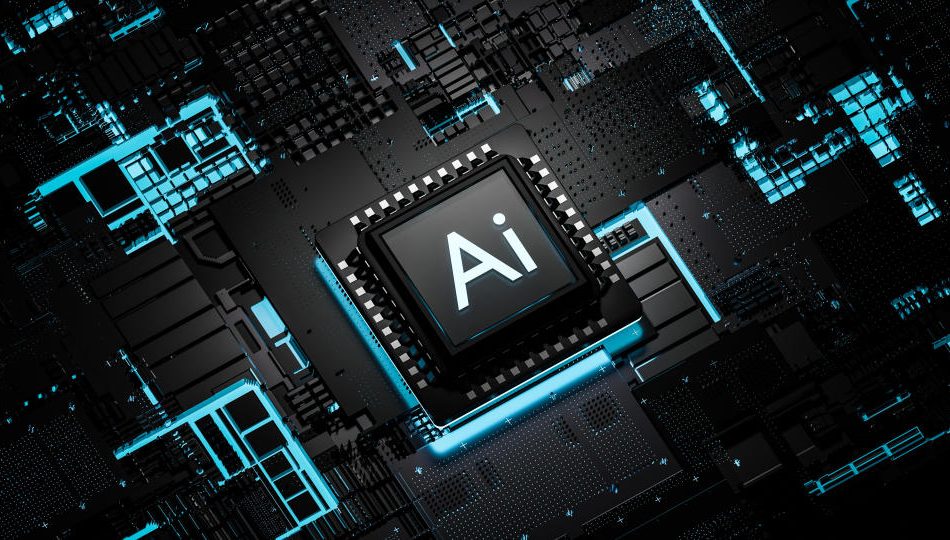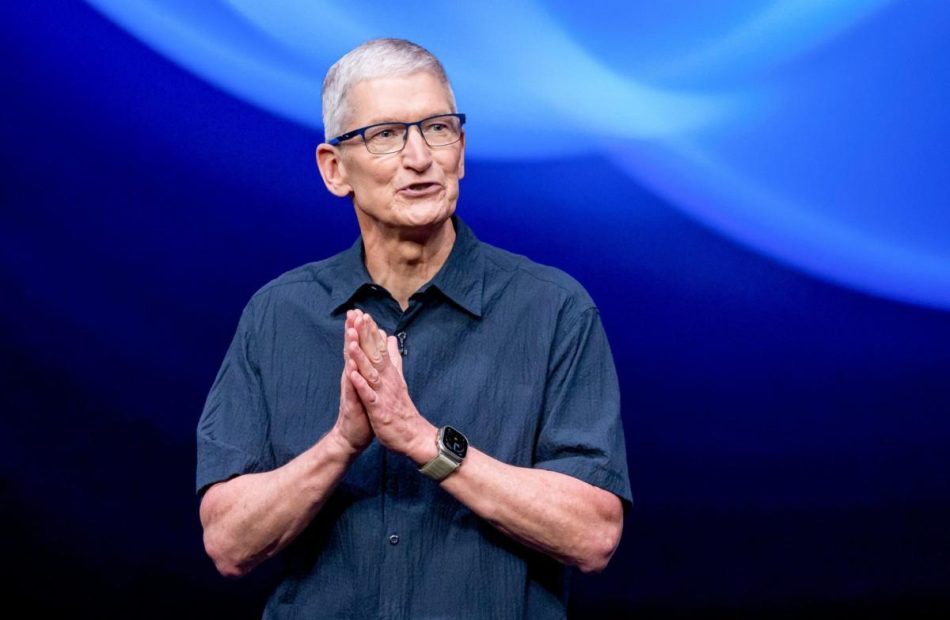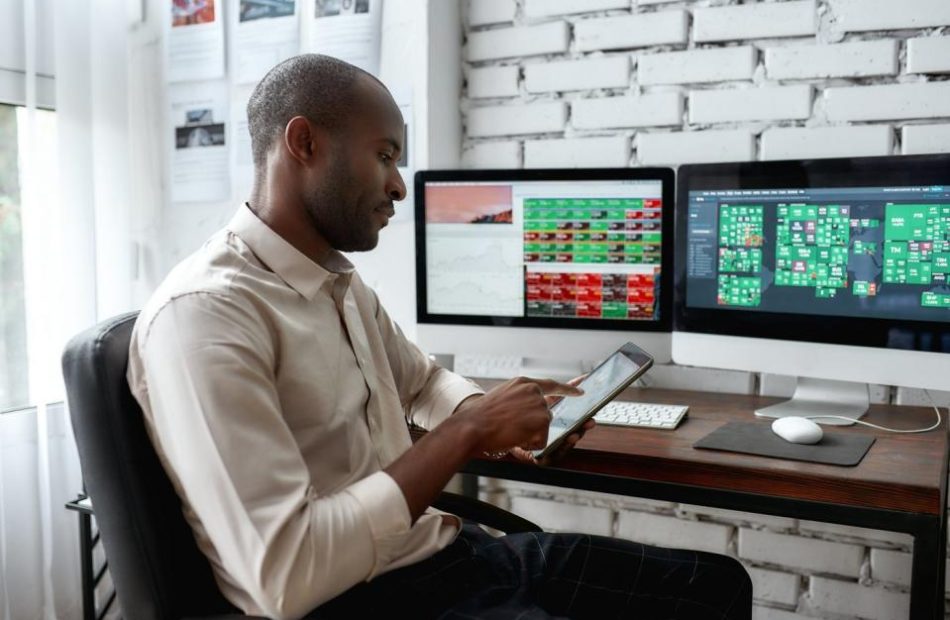How capitalism will keep AI from ruining everything
A version of this article first appeared on TKer.co
Artificial intelligence (AI) is white hot right now. Companies everywhere are bullish on the promise of taking mountains of data, processing it, and producing cost-effective goods and services that are on par with or better than what could be made by humans.
Some jobs are expected to become obsolete while new jobs are created. And the improved productivity is expected to bolster margins and drive profit growth for companies, which is good news for the stock market.
But all this talk mostly focuses on financial benefits, and it conjures up images of a bleak dystopia where the human touch is gone after its intangible value has been taken for granted.
The good news is that history says emerging technologies don’t mean the end of whatever they were meant to improve on.
“As the ubiquity of technology increases and individuals increase their reliance on technology as they communicate via networks, the value they place on ‘authenticity’ and human connectivity – which can evoke a nostalgic image of a simpler, pre-digital life – is likely to grow,” Goldman Sachs’ Peter Oppenheimer wrote. “This is true across many product categories, including food.”
In a research report exploring AI, Oppenheimer highlights examples of hand-crafted, low-tech, “retro” goods and services that survived technological progress. From his note:
…The growth of artificial immersive entertainment may also boost demand for experiences in the real world. This might reflect the growing popularity of goods and services that are seen as ‘authentic’ or nostalgic. Retro ‘crafts’ are growing in popularity, whether it be the growth reality TV programmes where contestants compete in baking, spelling, sowing or even ballroom dancing competitions.
These fashions are spreading into retail. According to Grand View Research, for example, the market for so-called ‘artisanal’ bakery products was valued globally at $95.13 billion in 2022 and is likely to grow at a compound rate of 5.7% from 2023 to 2030. The focus on sustainability and interest in the past together create new consumer markets. According to research conducted by GlobalData for ThredUP, a US second-hand store, the resale clothes market is growing at 15 times the rate of traditional retail. According to a report by Statistica, as of 2021, 42% of millennials and Gen Z respondents stated that they were likely to shop for second-hand items.
You might assume the broad uptake of the wide array of ridesharing options means demand for modes of transport that you own would fall apart. That’s not been the case. From the note:
A similar trend has emerged in transport with the growth in the ‘sharing’ economy and the growth of cycle, scooter and car sharing. Few would have predicted the steady growth in the bicycle market a decade ago; the global bicycle market was valued at over $64 billion in 2022 and is expected to grow at a compound rate of 9.7% from 2023 to 2030. Perhaps even more striking is how the bicycle is outselling the car. Analysis of 30 European countries by the Confederation of the European Bicycle Industry (CONEBI) and the European Cyclists Federation (ECF) suggests that, at the current trajectory, 10 million more bikes will be sold per year in Europe by 2030, representing a rise of 47% compared with 2019. On this basis, the 30 million bikes sold annually in Europe would be more than double the annual sales of cars.
As the world moves forward, it’s interesting to think about the value consumers place on the past. From the note:
In the 21st century, in a highly digitalised world where almost everyone is connected to the internet and the cutting edge of technology threatens to displace jobs and companies, it is meaningful that one of the biggest companies in Europe is LVMH. This is a company that sells the value of heritage in historic brands. It was formed in 1987 through the merger of two old companies: Louis Vuitton (founded in 1854) and Moet Hennessey, which itself was a merger in 1971 between Moet & Chandon, the champagne producer (founded in 1743) and Hennessey, producer of cognac (founded in 1765). According to its website, the company develops the brands that ‘perfectly encapsulate all that they have embodied for our customers for centuries.
Intangible value is a kind of value. And people are finding it in goods and services that have arguably been improved on.
It’s not easy to explain why we value this stuff. But the point is we do.
And we demand this stuff.
And when enough people demand something, there’ll be businesses to supply that thing. It’s just basic economics and capitalism at work.
Reviewing the macro crosscurrents
There were a few notable data points and macroeconomic developments from last week to consider:
Inflation cools. The Consumer Price Index (CPI) in August was up 2.5% from a year ago, down from the 2.9% rate in July. This was the lowest print since February 2021. Adjusted for food and energy prices, core CPI was up 3.2%, unchanged from the prior month’s rate.
On a month-over-month basis, CPI was up 0.2% as energy prices fell 0.8%%. Core CPI increased by 0.3%.
If you annualize the three-month trend in the monthly figures — a reflection of the short-term trend in prices — CPI rose 1.1% and core CPI climbed 2.1%.
Inflation rates have been hovering near the Federal Reserve’s target rate of 2%, which is why the central bank has been signaling that rate cuts may be around the corner.
Inflation expectations remain cool. From the New York Fed’s September Survey of Consumer Expectations: “Median inflation expectations at the one- and five-year horizons remained unchanged in August at 3.0% and 2.8%, respectively. Median inflation expectations at the three-year horizon rebounded somewhat from the low July reading, increasing from 2.3% to 2.5%.”
“Year-ahead inflation expectations fell for the fourth straight month, coming in at 2.7%. The current reading is the lowest since December 2020 and is well within the 2.3-3.0% range seen in the two years prior to the pandemic. Long-run inflation expectations were little changed, edging up from 3.0% last month to 3.1% this month. Long-run inflation expectations remain modestly elevated relative to the range of readings seen in the two years pre-pandemic.”
Consumer vibes improve. From the University of Michigan’s September Surveys of Consumers: “Consumer sentiment rose to its highest reading since May 2024, increasing for the second consecutive month and lifting about 2% above August. The gain was led by an improvement in buying conditions for durables, driven by more favorable prices as perceived by consumers. Year-ahead expectations for personal finances and the economy both improved as well, despite a modest weakening in views of labor markets.”
Wage growth is cooling. According to the Atlanta Fed’s wage growth tracker, the median hourly pay in August was up 4.6% from the prior year, down from the 4.7% rate in July.
Oil prices fall. Brent crude futures fell below $70 a barrel for the first time in more than two years on Tuesday, closing at its lowest level since December 2021. From Bloomberg: “Downbeat economic data from the US and China — including weak import figures released Tuesday — have stirred fears about oil demand in the top two consumers, adding to concerns that a surplus will emerge next year and fueling record bearish positioning. That’s being compounded by surging output in producing nations outside the Organization of Petroleum Exporting Countries.”
Gas prices fall. From AAA: “The national average for a gallon of gas kept up its torrid pace of decline, sinking six cents since last week to $3.24. The primary culprits behind the dip are low demand and falling oil costs.”
Real incomes are up. From the Census: “Real median household income was $80,610 in 2023, a 4.0% increase from the 2022 estimate of $77,540. This is the first statistically significant annual increase in real median household income since 2019.”
Meanwhile, poverty ticked lower. From the Census: “In 2023, the official poverty rate fell 0.4 percentage points to 11.1%. There were 36.8 million people in poverty in 2023, not statistically different from 2022.”
Card spending data is stable. From Bank of America: “Bank of America aggregated credit and debit card spending per household rose 0.9% year-over-year (YoY) in August, rebounding from the 0.4% YoY decline in July. On a month-over-month (MoM) basis, spending in August decreased 0.2% after rising 0.3% in July. In our view, this reflects a normalization of consumer spending as opposed to a weakening. Within the total, services spending momentum remains stronger than goods.”
Unemployment claims ticked higher. Initial claims for unemployment benefits rose to 230,000 during the week ending September 7, up from 228,000 the week prior. This metric continues to be at levels historically associated with economic growth.
Mortgage rates fall. According to Freddie Mac, the average 30-year fixed-rate mortgage fell to 6.2%, down from 6.35% last week. From Freddie Mac: “Mortgage rates have fallen more than half a percent over the last six weeks and are at their lowest level since February 2023. Rates continue to soften due to incoming economic data that is more sedate. But despite the improving mortgage rate environment, prospective buyers remain on the sidelines, as they negotiate a combination of high house prices and persistent supply shortages.”
There are 146 million housing units in the U.S., of which 86 million are owner-occupied and 39% of which are mortgage-free. Of those carrying mortgage debt, almost all have fixed-rate mortgages, and most of those mortgages have rates that were locked in before rates surged from 2021 lows. All of this is to say: Most homeowners are not particularly sensitive to movements in home prices or mortgage rates.
Small business optimism deteriorates. The NFIB’s Small Business Optimism Index in August fell.
Importantly, the more tangible “hard” components of the index continue to hold up much better than the more sentiment-oriented “soft” components.
Keep in mind that during times of perceived stress, soft data tends to be more exaggerated than actual hard data.
Near-term GDP growth estimates remain positive. The Atlanta Fed’s GDPNow model sees real GDP growth climbing at a 2.5% rate in Q3.
Putting it all together
We continue to get evidence that we are experiencing a bullish “Goldilocks” soft landing scenario where inflation cools to manageable levels without the economy having to sink into recession.
This comes as the Federal Reserve continues to employ very tight monetary policy in its ongoing effort to get inflation under control. Though, with inflation rates having come down significantly from their 2022 highs, the Fed has taken a less hawkish tone in recent months — even signaling that rate cuts begin soon.
It would take a number of rate cuts before we’d characterize monetary policy as being loose, which means we should be prepared for relatively tight financial conditions (e.g., higher interest rates, tighter lending standards, and lower stock valuations) to linger. All this means monetary policy will be relatively unfriendly to markets for the time being, and the risk the economy slips into a recession will be relatively elevated.
At the same time, we also know that stocks are discounting mechanisms — meaning that prices will have bottomed before the Fed signals a major dovish turn in monetary policy.
Also, it’s important to remember that while recession risks may be elevated, consumers are coming from a very strong financial position. Unemployed people are getting jobs, and those with jobs are getting raises.
Similarly, business finances are healthy as many corporations locked in low interest rates on their debt in recent years. Even as the threat of higher debt servicing costs looms, elevated profit margins give corporations room to absorb higher costs.
At this point, any downturn is unlikely to turn into economic calamity given that the financial health of consumers and businesses remains very strong.
And as always, long-term investors should remember that recessions and bear markets are just part of the deal when you enter the stock market with the aim of generating long-term returns. While markets have recently had some bumpy years, the long-run outlook for stocks remains positive.
For more on how the macro story is evolving, check out the the previous TKer macro crosscurrents »
Missed Out on Viking Therapeutics? Buy This Weight Loss Biotech Stock Right Now.
Shares of biotechnology companies like Viking Therapeutics (NASDAQ: VKTX) have exploded upward by over 300% in the last 12 months, thanks to its phenomenal clinical data from its late-stage weight loss drug program.
The biotech industry is frequently rife with exciting opportunities for the more risk-tolerant investors, and it should come as no surprise that investors who missed the Viking rally may be looking for a similar opportunity within this space that could be just as juicy.
While it’s debatable whether the opportunity with Viking is actually in the rearview mirror or merely taking a breather until its next set of clinical catalysts — and it’s probably the latter — there’s another pre-revenue weight loss biotech that’s worth paying attention to: Terns Pharmaceuticals (NASDAQ: TERN).
And while there’s no definitive guarantee Terns will imitate Viking’s recent run, its current conditions feature many of the same ingredients that led to the latter’s success. In short, I’d argue that Tern’s shares are primed to take off. Let’s take a look and make a few illustrative comparisons.
The conditions are ripe for a big run
Whereas Viking Therapeutics saw its shares fly due to favorable phase 2 trial results with its lead candidate, Terns is slightly less mature. Its orally delivered anti-obesity program, TERN-601, just reported some good phase 1 results on Sept. 9, and it plans to advance the candidate into phase 2 sometime in 2025.
In practical terms, investors who buy Terns today are thus exposed to a higher degree of clinical data risk than they would be if they bought shares of Viking, but the upside could be higher too. The phase 1 trial data suggest that TERN-601 is sufficiently safe and its side effects reasonably tolerable for patients. So the next big hurdle will be to demonstrate that its efficacy at weight loss is both sufficient on its own terms and at least as good as the products on the market made by Eli Lilly and Novo Nordisk.
The phase 1 data offers a sneak peek into how the biotech will fare on those fronts. At the highest dose level tested in the trial, the nine patients in the group lost an average of 5.5% of their body weight after 28 days of treatment, or 4.9% on a placebo-adjusted basis.
While it isn’t possible to make a scientifically rigorous direct comparison with other drug developers’ weight loss programs for a handful of reasons, Terns’ data preliminarily suggests that its candidate could be (broadly speaking) competitive with Viking’s in terms of the proportion of weight lost per unit of time, and perhaps superior to Eli Lilly’s drug Zepbound.
That supports the idea that the market could react very positively to the program advancing through the phases of clinical trials, just like it did with Viking. What’s more, Terns might also have an edge over Viking’s program in terms of the candidate’s tolerability for patients, though a conclusive judgment will need to wait until the business publishes or presents the full results of the trial rather than just a high-level summary.
If the early data on better tolerability are substantiated, it could open a few doors for the biotech that will meaningfully increase its addressable market. In particular, a highly tolerable weight loss pill would be ripe for combining with other medicines made by Terns that could treat multiple conditions at once, or increase the pace of weight loss.
The long-term picture could become even better than it is
Terns is also fairly well-funded, though admittedly it’s nowhere near as flush with cash as Viking. As of the second quarter, it reported $225 million in cash, equivalents, and short-term investments, whereas its trailing-12-month research and development (R&D) expenses were only $69.2 million. But considering it had more money in the bank than Viking at the start of 2023, it’s clear that with the right mid-stage data, Terns stands to see a cash infusion from issuing new stock.
Of course, that’s a risk, as it would dilute the value of existing shareholders. On the other hand, given the market’s affection for weight loss stocks at the moment, investors will probably be more likely to interpret a new influx of cash as a bullish factor rather than a bearish one — once again, assuming that the company’s clinical data continues to impress in the key dimensions we’ve been discussing.
So is Terns stock worth buying today in hopes of it following Viking’s trajectory?
While it might not perfectly follow in the larger biotech’s footsteps, TERN-601 has the potential to be one of the safer, more tolerable, and more effective weight loss pill candidates remaining alive and well, the stock has a solid case for upside — and the company won’t have any trouble reaching its next set of milestones financing wise.
With all that being said, if you can accept that it’s a risky biotech stock without any sales for the next few years, it’s worth buying a few shares. At the moment, Terns’ future is bright, and it’s probably just getting started.
Should you invest $1,000 in Terns Pharmaceuticals right now?
Before you buy stock in Terns Pharmaceuticals, consider this:
The Motley Fool Stock Advisor analyst team just identified what they believe are the 10 best stocks for investors to buy now… and Terns Pharmaceuticals wasn’t one of them. The 10 stocks that made the cut could produce monster returns in the coming years.
Consider when Nvidia made this list on April 15, 2005… if you invested $1,000 at the time of our recommendation, you’d have $729,857!*
Stock Advisor provides investors with an easy-to-follow blueprint for success, including guidance on building a portfolio, regular updates from analysts, and two new stock picks each month. The Stock Advisor service has more than quadrupled the return of S&P 500 since 2002*.
*Stock Advisor returns as of September 9, 2024
Alex Carchidi has no position in any of the stocks mentioned. The Motley Fool recommends Novo Nordisk. The Motley Fool has a disclosure policy.
Missed Out on Viking Therapeutics? Buy This Weight Loss Biotech Stock Right Now. was originally published by The Motley Fool
‘Serious energy deflation’ is coming whether Trump or Harris wins, says analyst
In their bids to win the 2024 election, former President Donald Trump has promised to “drill, baby, drill” to lower energy prices, while Vice President Kamala Harris has assured she won’t ban fracking.
Those promises may not matter much in the near term. Energy prices are poised to drop, regardless of who wins, says one industry watcher.
“Whoever gets elected in November is going to be very fortunate in that they are going to be dealing with some of the most serious energy deflation … since 2020,” Tom Kloza, OPIS Global head of energy analysis, told Yahoo Finance, referring to the start of the pandemic lockdowns four years ago when US crude prices slumped as travel demand collapsed.
This past week was one of the year’s most volatile for the energy markets as oil touched its lowest level since 2021 before ticking higher on Wednesday. Year to date, West Texas Intermediate (CL=F) is down about 2%, while Brent (BZ=F), the international benchmark, is down more than 4%.
Gasoline prices have also fallen to their lowest level since February, with the national average at $3.24 per gallon, according to AAA.
Prices are expected to go lower as the industry soon switches to a cheaper winter-grade gasoline. Analysts predict the national average will dip below $3 per gallon in the coming weeks barring an unforeseen event.
“These sub-$3 prices are sure to boost consumer sentiment going into the fall,” GasBuddy head of petroleum analysis Patrick De Haan told Yahoo Finance.
Weak demand out of China, the biggest importer of oil, has been the main driver of declining crude prices. The country has been battling a housing crisis while shifting toward electric vehicles and more natural gas consumption.
Cracks in the US economy and Europe have also weighed on the markets, keeping some speculators notably at bay.
“What happened this summer and what continues to happen is that you do not have speculators buying futures and options contracts anymore,” said Kloza. “The fact that we didn’t see more speculative money coming into the market … that might represent a real sea change for oil.”
“Right now, financial participation in oil markets is probably as low as it’s been since oil became an asset class,” said Kloza.
The fall in oil prices has been so rapid that Wall Street analysts have been forced to revise down their forecasts. On Monday, Morgan Stanley cut its Brent price target for the second time in a matter of weeks, citing risks of “considerable demand weakness.”
The analysts forecast Brent will average $75 per barrel in the fourth quarter of this year, $5 lower than the prior downwardly revised outlook of $80 issued in late August.
Oil demand growth forecasts have also come down. The International Energy Agency cut its outlook for 2024, citing Chinese oil demand “firmly in contraction.”
The revision came the same week oil alliance OPEC slightly trimmed its own oil demand forecast. Despite the revision, OPEC’s expectations are still near double other industry estimates.
The oil alliance spearheaded by Saudi Arabia has been eager to bring back more of its supply by unwinding some of its production cuts, which have helped keep a floor on prices.
However, the cartel recently delayed the reintroduction of barrels initially slated for October given the slump in oil. The postponement didn’t do much to boost prices.
“OPEC+ still has a significant amount of oil that is just waiting to return to the market. And I think that’s the concern — is there really that demand to really satisfy and absorb that increased oil that is going to come back to the market sometime soon?” Tortoise senior portfolio manager Rob Thummel told Yahoo Finance on Wednesday.
In a nod to centrists, during Tuesday’s event Harris underscored record production in the US, the largest oil and gas producer in the world.
“We have invested a trillion dollars in a clean energy economy while we have also increased domestic gas production to historic levels,” said Harris.
Meanwhile, at rallies, Trump has promised to produce even more oil in order to cut energy prices in half and bring gasoline below $2 per gallon, though analysts expect producers to keep his “drill, baby, drill” vow in check if prices go too low.
On average, companies need the price of US crude to be at least $64 per barrel in order to profitably drill a new well, and $39 for existing ones, according to the Dallas Federal Reserve survey.
With WTI trading near $69, production is expected to continue growing amid technological breakthroughs. The US reached peak production last year despite declining US drilling activity because new wells are more efficient, according to government data. US oil production next year is expected to reach another record level, given advances in horizontal drilling and fracking.
“Ukraine war, the COVID lockdowns, those are the things that shaped oil prices in the last four years,” said OPIS’s Kloza.
“The more likely thing is that we’re going to see much more modest prices next year, and we’ll see oil trade in [on] a lot quieter terms than we have for the last three years,” he added.
Ines Ferre is a senior business reporter for Yahoo Finance. Follow her on X at @ines_ferre.
Click here for in-depth analysis of the latest stock market news and events moving stock prices
Read the latest financial and business news from Yahoo Finance
SMCI INVESTOR ALERT: Bronstein, Gewirtz & Grossman LLC Announces that Super Micro Computer, Inc. Investors with Substantial Losses Have Opportunity to Lead Class Action Lawsuit!
NEW YORK, Sept. 15, 2024 (GLOBE NEWSWIRE) — Attorney Advertising — Bronstein, Gewirtz & Grossman, LLC, a nationally recognized law firm, notifies investors that a class action lawsuit has been filed against Super Micro Computer, Inc. (“Super Micro” or “the Company”) SMCI and certain of its officers.
Class Definition
This lawsuit seeks to recover damages against Defendants for alleged violations of the federal securities laws on behalf of all persons and entities that purchased or otherwise acquired Super Micro securities between August 31, 2023, and August 28, 2024, inclusive (the “Class Period”). Such investors are encouraged to join this case by visiting the firm’s site: bgandg.com/SMCI.
Case Details
The Complaint alleges that throughout the Class Period, Defendants made false and/or misleading statements and/or failed to disclose, among other things, that: (1) defendants recognized revenue prematurely and failed to implement adequate internal financial controls; (2) defendants failed to disclose the existence of multiple related party transactions; and (3) as a result, defendants’ statements about its business, operations, and prospects, were materially false and misleading and/or lacked a reasonable basis at all relevant times. When the true details entered the market, the lawsuit claims that investors suffered damages.
What’s Next?
A class action lawsuit has already been filed. If you wish to review a copy of the Complaint, you can visit the firm’s site: bgandg.com/SMCI or you may contact Peretz Bronstein, Esq. or his Client Relations Manager, Nathan Miller, of Bronstein, Gewirtz & Grossman, LLC at 332-239-2660. If you suffered a loss in Super Micro you have until October 29, 2024, to request that the Court appoint you as lead plaintiff. Your ability to share in any recovery doesn’t require that you serve as lead plaintiff.
There is No Cost to You
We represent investors in class actions on a contingency fee basis. That means we will ask the court to reimburse us for out-of-pocket expenses and attorneys’ fees, usually a percentage of the total recovery, only if we are successful.
Why Bronstein, Gewirtz & Grossman
Bronstein, Gewirtz & Grossman, LLC is a nationally recognized firm that represents investors in securities fraud class actions and shareholder derivative suits. Our firm has recovered hundreds of millions of dollars for investors nationwide.
Attorney advertising. Prior results do not guarantee similar outcomes.
Contact
Bronstein, Gewirtz & Grossman, LLC
Peretz Bronstein or Nathan Miller
332-239-2660 | info@bgandg.com

Market News and Data brought to you by Benzinga APIs
© 2024 Benzinga.com. Benzinga does not provide investment advice. All rights reserved.
2 Artificial Intelligence (AI) Stocks to Buy With $1,000 and Hold for Decades
Last week, Oracle Chairman Larry Ellison offered investors some fresh insights into the current state of artificial intelligence (AI). He said there was no slowdown in sight in terms of business spending on the development of AI. Indeed, he thinks the industry will expand significantly for at least the next 10 years.
Oracle currently has 162 data centers online and under construction, but Ellison thinks that number could reach 2,000 over the long term.
If he’s right, this might be a fantastic time to buy AI stocks, especially after the recent sell-off across the technology sector. Investors with $1,000 to put to work now might want to split it equally between shares of chip giant Micron Technology (NASDAQ: MU) and cloud computing company DigitalOcean (NYSE: DOCN).
1. Micron Technology: A leader in memory chips for AI
AI is trained and powered by data center servers that use powerful graphics processing units (GPUs), most of which have been supplied by Nvidia. Memory chips are complementary to GPUs because they store information in a ready state so it can be called upon instantly, which is particularly critical in data-intensive AI workloads.
Micron’s HBM3e was selected by Nvidia for inclusion in its new H200 GPU. That high-bandwidth memory architecture offers several benefits over previous generations of chips, including a higher capacity and a smaller physical footprint. Plus, Micron’s HBM3e is 30% more energy efficient than competing chips, and electricity consumption is a key consideration for data center operators when selecting hardware.
Micron recently told investors it had already sold out all the data center memory it would be able to deliver in 2024 and 2025, which isn’t surprising, given that demand for Nvidia’s GPUs is significantly outstripping supply. Some industry sources have said Micron is gearing up to manufacture a new 12-layer HBM3e solution, implying a 50% increase in capacity, which will be ideal for Nvidia’s upcoming Blackwell-based GPUs like the B200. So investors should not expect demand for Micron’s high-bandwidth memory to slow anytime soon.
However, Micron’s opportunities transcend the data center, because some hardware to power AI applications is shifting to personal computers and devices too, thanks to increasingly powerful neural processing units (NPUs) from the likes of Apple and Advanced Micro Devices. Micron says AI-enabled smartphones, for example, require up to twice as much memory capacity than their predecessors. That will be a direct tailwind for the company’s revenue.
In its fiscal 2024 third quarter, which ended May 30, Micron delivered an 85% increase in its data center revenue and a whopping 94% increase in its mobile segment revenue, thanks to AI demand. The company will report its final results for fiscal 2024 at the end of September, and analysts expect to see $25 billion in total revenue, a 61% jump from fiscal 2023. Wall Street’s early forecast for fiscal 2025 points to $38.8 billion in revenue, representing further growth of 53%.
But it gets better. Analysts predict Micron could generate $9.41 per share in earnings in fiscal 2025, placing its stock at a forward price to earnings (P/E) ratio of just 9.6. That means Micron stock would have to triple to trade in line with Nvidia stock, which currently has a forward P/E ratio of 29.1. Considering how closely linked the two companies are, Micron looks like a great value at the current price for investors willing to hold on to the stock for the long term.
2. DigitalOcean: An AI cloud provider for small and mid-sized businesses
Circling back to Ellison’s comments, the race to build data centers is being spurred by rising demand for AI cloud services. Providers like Amazon Web Services and Microsoft Azure are leaders in that space, but they primarily target large organizations with deep pockets. DigitalOcean, on the other hand, has carved out a lucrative niche by serving small and mid-sized businesses (SMBs).
DigitalOcean’s initial success stemmed from a portfolio of cloud services such as data storage, web hosting, video streaming, and software development tools. It offers cheap and transparent pricing, a simple dashboard with one-click deployment features, and personalized support, all of which are important for SMBs.
However, last year, DigitalOcean acquired Paperspace, which operates several data centers with a range of GPU options designed for AI developers. DigitalOcean recently announced it will allow customers to access fractional GPU capacity on demand, which has never been done before. In other words, SMBs can use between one and eight Nvidia H100 GPUs to power their AI workloads, a tiny scale that cloud leaders simply won’t offer because it isn’t cost-efficient for them.
We already know that Paperspace can be up to 70% cheaper than equivalent services from Microsoft Azure, for example, because it offers per-second billing with no lock-in contracts. Plus, the company has a lean cost structure because of its narrow portfolio of services, so customers aren’t paying for things they may never use. With those services combined with DigitalOcean’s new fractional GPU offering, even the smallest businesses can start deploying AI.
DigitalOcean generated $192.5 million in revenue during the second quarter, a 13% increase from the prior-year period. However, its revenue attributable to AI soared by a whopping 200%, suggesting SMBs are latching on to the company’s new services at a rapid pace.
The stock now trades at a price-to-sales ratio of 5.1, which is 41% below its average of 8.7 since the company came public in 2021, so it looks like a good value right now. As one of the only cloud providers that is truly focused on the needs of SMBs, DigitalOcean could be a great addition to any portfolio as the AI opportunity expands over the long term.
Should you invest $1,000 in Micron Technology right now?
Before you buy stock in Micron Technology, consider this:
The Motley Fool Stock Advisor analyst team just identified what they believe are the 10 best stocks for investors to buy now… and Micron Technology wasn’t one of them. The 10 stocks that made the cut could produce monster returns in the coming years.
Consider when Nvidia made this list on April 15, 2005… if you invested $1,000 at the time of our recommendation, you’d have $729,857!*
Stock Advisor provides investors with an easy-to-follow blueprint for success, including guidance on building a portfolio, regular updates from analysts, and two new stock picks each month. The Stock Advisor service has more than quadrupled the return of S&P 500 since 2002*.
*Stock Advisor returns as of September 9, 2024
John Mackey, former CEO of Whole Foods Market, an Amazon subsidiary, is a member of The Motley Fool’s board of directors. Anthony Di Pizio has no position in any of the stocks mentioned. The Motley Fool has positions in and recommends Advanced Micro Devices, Amazon, Apple, DigitalOcean, Microsoft, Nvidia, and Oracle. The Motley Fool recommends the following options: long January 2026 $395 calls on Microsoft and short January 2026 $405 calls on Microsoft. The Motley Fool has a disclosure policy.
2 Artificial Intelligence (AI) Stocks to Buy With $1,000 and Hold for Decades was originally published by The Motley Fool
Why I Just Loaded Up on This Dirt Cheap High-Yield Dividend Stock
For years, the top advertising slogan for Prudential Financial (NYSE: PRU) was “Get a piece of the rock.” The global financial services and investment management company still uses the iconic image of the Rock of Gibraltar in its logo.
I just got a piece of the rock. Instead of buying insurance or another financial product from Prudential, though, I invested in the company. Here’s why I just loaded up on this dirt cheap, high-yield dividend stock.
1. Its rock-solid business
No pun intended, but my main reason for buying Prudential Financial stock was its rock-solid business. The company has survived and thrived since 1875, and its nearly 150-year track record of success makes me confident in its ability to adapt to changing times.
Prudential started as an insurance company. While it’s still a leader in the insurance industry, it also manages investments and offers a wide range of financial products, including annuities, today.
The company has assets under management of nearly $1.5 trillion. It serves around 50 million customers in over 50 countries and boasts an AA (very strong) financial strength rating.
Even better, Prudential has solid long-term growth prospects — especially in selling retirement products and services. The company estimates a $137 trillion retirement opportunity in the U.S. and a $26 trillion opportunity in Japan by 2050 due to aging demographics.
In addition to Japan, Prudential also has excellent growth prospects in other international markets. Emerging markets, including Africa, China, Latin America, and Southeast Asia, have expanding middle and upper classes. The insurance penetration is low in many of these areas.
2. Its attractive valuation
Prudential Financial stock trades at only 7.8 times forward earnings. By comparison, the S&P 500‘s forward earnings multiple is 21.4. The S&P 500 financials sector average forward earnings multiple is 16.2. When I said Prudential stock is dirt cheap, I wasn’t kidding.
And there’s more. Prudential’s price-to-earnings-to-growth (PEG) ratio based on five-year growth projections is 0.49, according to LSEG. Any PEG ratio below 1.0 is considered an attractive valuation.
PEG ratios are usually more applicable to high-flying growth stocks. Prudential doesn’t belong in that group. However, I think its super-low PEG ratio underscores what a bargain this stock truly is right now.
3. Its juicy dividend
I wasn’t kidding about Prudential’s high dividend yield, either. The company offers a forward dividend yield of 4.53%. With such a juicy dividend, Prudential won’t need much share price appreciation to deliver solid total returns.
What I like even more is that Prudential has increased its dividend for 16 consecutive years. Unlike some companies that hike their dividends by minuscule amounts just to maintain their streaks, Prudential has rewarded shareholders with meaningful dividend increases. Since 2008, its dividend has risen by a compound annual growth rate (CAGR) of 15%. Over the last five years, Prudential has increased its dividend by a CAGR of 7%.
The company should have no problems keeping its dividends flowing and growing. According to LSEG, Prudential’s dividend payout ratio is a respectable 65%.
I’d be remiss if I left out the financial services leader’s “invisible dividends.” Prudential returned $500 million to shareholders through stock buybacks in the first half of 2024. It has another $500 million remaining on the current share repurchase authorization, which ends Dec. 31, 2024.
Should you invest $1,000 in Prudential Financial right now?
Before you buy stock in Prudential Financial, consider this:
The Motley Fool Stock Advisor analyst team just identified what they believe are the 10 best stocks for investors to buy now… and Prudential Financial wasn’t one of them. The 10 stocks that made the cut could produce monster returns in the coming years.
Consider when Nvidia made this list on April 15, 2005… if you invested $1,000 at the time of our recommendation, you’d have $729,857!*
Stock Advisor provides investors with an easy-to-follow blueprint for success, including guidance on building a portfolio, regular updates from analysts, and two new stock picks each month. The Stock Advisor service has more than quadrupled the return of S&P 500 since 2002*.
*Stock Advisor returns as of September 9, 2024
Keith Speights has positions in Prudential Financial. The Motley Fool has no position in any of the stocks mentioned. The Motley Fool has a disclosure policy.
Why I Just Loaded Up on This Dirt Cheap High-Yield Dividend Stock was originally published by The Motley Fool
Russia Security Council Head Warns Of Turning Kyiv Into A 'Giant Melted Spot' Using New Technologies
Russia has issued a stern warning to Ukraine, threatening to reduce its capital, Kyiv, to a “giant melted spot” if Ukraine is allowed by its allies to use Western long-range missiles against Russia.
What Happened: Moscow’s warning came on Saturday, as reported by Politico. The threat was made by Dmitry Medvedev, deputy chairman of Russia’s Security Council, amidst ongoing discussions by the U.S. and the U.K. to permit Ukraine to use Western weapons to strike strategic targets within Russia.
Medvedev, known for his nuclear rhetoric, stated that Russia already has “formal” grounds to use nuclear weapons following Ukraine’s incursion into Russia’s Kursk region. However, he suggested that newer technologies could be used to create a “giant melted spot” in place of the Ukrainian capital.
Despite the threats, Medvedev acknowledged that “a nuclear conflict is really not needed by anyone,” adding that a nuclear response is a decision with “irreversible consequences.”
Meanwhile, U.K. Prime Minister Keir Starmer and U.S. President Joe Biden have been discussing Ukraine’s possible use of British-made Storm Shadow cruise missiles on Russian soil, without reaching a decision. Russian President Vladimir Putin warned that such permission would put NATO countries “at war with Russia.”
Ukrainian President Volodymyr Zelenskyy has renewed Kyiv’s pleas for expanded use of Western weapons, stating, “We are making progress on the battlefield. But we need permission to use long-range weapons.”
Why It Matters: This development comes in the wake of calls from Russian foreign policy hawks for a more assertive nuclear stance towards the West.
The use of Western-made long-range missiles by Ukraine against Russia could lead to a direct military confrontation between Russia and the West, as warned by Putin.
The situation has also raised global concerns, with Tesla and SpaceX CEO Elon Musk expressing his apprehension about potential global conflict.
Photo by Michael Parulava on Unsplash
Did You Know?
This story was generated using Benzinga Neuro and edited by Shivdeep Dhaliwal
Market News and Data brought to you by Benzinga APIs
© 2024 Benzinga.com. Benzinga does not provide investment advice. All rights reserved.
The Magnificent Seven is less expensive. Buying these tech giants now could pay off
Warren Buffett once said it can pay “to be fearful when others are greedy and to be greedy only when others are fearful.”
Since the GenAI boom took hold last year, investors have hopped on the bandwagon of the Magnificent Seven—a movie-inspired moniker that refers to Alphabet, Amazon, Apple, Meta, Microsoft, Nvidia, and Tesla—and the group accounted for half the S&P 500’s total gains in 2023, according to a report from Morgan Stanley.
After a blistering start to 2024, however, many of these large-cap tech giants have fallen back down to Earth. Could it be time to buy the dip? Here are three members of the Magnificent Seven that Wall Street remains high on.
Apple
Speaking of Buffett, the Oracle of Omaha made plenty of headlines when the Berkshire Hathaway chairman sold half of its immense holding of Apple stock. It’s worth noting, however, that the iPhone maker remains Berkshire’s biggest equity holding overall.
Some believe the stock, which is up 20% year to date, is overvalued. Angelo Zino, a senior vice president and tech equity analyst at CFRA Research, understands why Monday’s unveiling of the iPhone 16—the first with significant GenAI features—didn’t spark a major reaction from investors. Nonetheless, he remains excited about the future of Apple’s wearables as new healthcare features are added, from sleep apnea detection on the Apple Watch to “clinical grade” hearing aids with the new AirPods Pro.
“Some of this wearable stuff is kind of being not talked about enough,” Zino said, “maybe because the AI stuff is taking all the limelight.”
The stock closed at $222.50 Friday, with the Street’s consensus price target sitting just short of $250.
Nvidia
Nvidia accounted for roughly 30% of the S&P 500’s total returns during the first half the year and is up almost 150% year to date. Analysts have made clear investors should not expect the chip designer’s shares to continue appreciating at the same pace, but the recent sell-off may have presented an attractive entry point.
Nvidia’s breakneck growth will inevitably slow, but demand for its GPUs remains insatiable. The stock popped over 13% this week as CEO Jensen Huang spoke Wednesday at a Goldman Sachs conference about juggling customers’ needs, underlining why the company is still, as Zino put it, the “center of the universe” when it comes to AI.
It should come as a surprise to no one, he said, that the tech giants, as well as smaller customers, hungrily await Nvidia’s next-generation Blackwell chips. That may be one reason the stock, which closed just above $119 on Friday, has a consensus price target topping $153.
Alphabet
However, the most underweighted mega-cap name, Zino said, is likely Alphabet, with the Google parent’s shares down 5% this month and up only 13.5% year to date, trailing the broader market.
A federal judge recently ruled Google had illegally monopolized the search market, which Bernstein analysts said could unleash future litigation that could cost the company over $100 billion. The Justice Department is even reportedly considering an effort to break up the business.
In recent notes to inventors, however, Zino said he believes those concerns are already discounted in the stock price. Investors are under-appreciating Google’s AI monetization opportunities, he said, as well as assets like Waymo, Google’s autonomous driving technology.
On Friday, Uber announced it will dispatch Waymo’s robotaxis in Austin and Atlanta by early 2025, expanding the footprint of Google’s self-driving cars beyond California and Arizona. Google shares closed above the $158 mark Friday, still below its consensus price target of roughly $204.
This story was originally featured on Fortune.com
Billionaire Bill Ackman's Latest $275 Million Investment Is Down 15% Since He Bought It. Should You Get In Now?
Bill Ackman is well-known for buying large stakes in what he believes are undervalued companies and using his influence as a major shareholder to push management to make changes to unlock value.
In May, Ackman revealed that he had established two new positions in his Pershing Square hedge fund, which holds an equity portfolio valued at over $10 billion. One of those positions, Brookfield Corp, has performed well since Ackman established his position. However, the other has seen its share price decline about 15% since he first purchased around $275 million worth of shares.
Ackman’s losing bet is Nike (NYSE: NKE). If he thought it was a value earlier, he probably thinks it’s an even better value at its lower price today. Should you take the opportunity to buy shares at a better price than the billionaire?
Why Ackman decided to “Just Do It”
In Pershing Square’s semi-annual report released last month, Ackman decided to defer discussion of his latest stock purchase. But there are a few things about Nike that might make it attractive to an investor like Ackman.
First of all, Nike shares were already down nearly 50% from their all-time high (reached in 2021) when Ackman decided to invest in the company. Today, they’re down 56%.
Nike’s share price declined as the the company stumbled in its transition toward direct-to-consumer sales. The company cut ties with many wholesalers in an effort to grow its direct relationships with consumers and sell through its own stores and website. However, it mismanaged inventory, which ended up eating into its profit margins.
But management has owned the missteps, and it’s getting back on track. Nike is still the leading athletic apparel brand in the world, and that brand value gives it a lot of leeway when taking on a new strategy. That brand, an intangible asset and a source of Nike’s competitive advantage in the market, is likely another reason Ackman found the stock attractive.
Nike’s decision to cut out many of its wholesale accounts was partially influenced by the ability to control its brand messaging with its e-commerce operations, branded stores, and specialty retailers. Nike is also looking to foster brand loyalty with its membership programs, including Nike Run Club, Nike Training Club, and other digital apps.
Lastly, Nike’s committed to delivering $2 billion in cumulative cost cuts over the next three years. A more efficient operation, combined with the shift toward more direct-to-consumer sales, should lead to higher operating margin over time.
Should you follow in Ackman’s footsteps?
The shift toward higher margin sales and operating efficiency should benefit the bottom line, but is Nike stock worth the price you’ll pay for shares today? Ackman seems to think so, likely having bought shares when they were trading well over $90 each. Today, you can buy shares for about 15% off.
A big part of that 15% drop came from a disappointing financial update released at the end of June. Sales fell 2% year over year for the fiscal 2024 fourth quarter, and management guided for a mid-single-digit decline in revenue for fiscal 2025. That’s driven by fewer product launches, reduced promotional activity, and macroeconomic uncertainty in China. That said, the company expects gross margin expansion over the next year.
Over time, sales growth should stabilize and gross margin should expand as more sales shift to digital, the Chinese market recovers, and Nike is able to exercise its brand strength and raise prices faster than the market.
Nike shares currently trade for just 25 times forward earnings estimates. It’s been years since Nike traded at a comparable level. As its operations once again reflect the strength of its brand, the company could see improved earnings growth with the potential for multiple expansion, leading to strong gains for shareholders over the long run.
Should you invest $1,000 in Nike right now?
Before you buy stock in Nike, consider this:
The Motley Fool Stock Advisor analyst team just identified what they believe are the 10 best stocks for investors to buy now… and Nike wasn’t one of them. The 10 stocks that made the cut could produce monster returns in the coming years.
Consider when Nvidia made this list on April 15, 2005… if you invested $1,000 at the time of our recommendation, you’d have $729,857!*
Stock Advisor provides investors with an easy-to-follow blueprint for success, including guidance on building a portfolio, regular updates from analysts, and two new stock picks each month. The Stock Advisor service has more than quadrupled the return of S&P 500 since 2002*.
*Stock Advisor returns as of September 9, 2024
Adam Levy has no position in any of the stocks mentioned. The Motley Fool has positions in and recommends Brookfield, Brookfield Corporation, and Nike. The Motley Fool has a disclosure policy.
Billionaire Bill Ackman’s Latest $275 Million Investment Is Down 15% Since He Bought It. Should You Get In Now? was originally published by The Motley Fool
Prediction: This Tech Stock Could Take Off After the iPhone 16 Launch (Hint: It's Not Apple)
Apple‘s much-awaited Sept. 9 event is finally in the rearview mirror, and it would be safe to say that there was nothing much to be surprised about. The technology giant revealed a new generation of iPhones that will support generative artificial intelligence (AI).
The new iPhone 16 lineup will get its first batch of generative AI features next month through a software update. It appears that the company will be gradually introducing AI tools from its Apple Intelligence suite of generative AI features as it looks to make a dent in an emerging smartphone niche that’s expected to take off big-time in the long run.
Market research firm IDC is forecasting a 364% year-over-year increase in shipments of generative AI smartphones this year to 234 million units. More importantly, the generative AI smartphone market is forecast to grow at an annual rate of 78% through 2028, clocking annual shipments of 912 million units as per IDC.
So, Apple is moving into the generative AI smartphone market at an opportune time when the demand for these devices is booming. That explains why Wedbush analyst Dan Ives expects Apple’s latest iPhones to kick off a solid upgrade cycle, with shipments expected to increase in the double digits in 2024 compared to last year’s near-4% increase in shipments. The company is expected to ship 240 million iPhones in fiscal 2025 thanks to the growing adoption of AI smartphones.
Now, it remains to be seen if the AI-enabled iPhones are good enough to give Apple’s top and bottom lines a nice boost. However, there’s one company that could be a bigger beneficiary of Apple’s iPhone 16 launch than the Cupertino-based tech giant itself — Arm Holdings (NASDAQ: ARM). Let’s look at the reasons why.
iPhone 16 lineup could boost Arm Holdings’ revenue and margins
Apple points out that its latest smartphones are “built for Apple Intelligence.” To make that happen, the company developed a new smartphone chip — the A18. The iPhone 16 and the iPhone 16 Plus will be powered by the A18 chip, while the Pro and Pro Max versions will have the A18 Pro chip inside them.
Apple has reportedly designed this chip using Arm Holdings’ Armv9 architecture, according to the Financial Times. Announced in 2021, the Armv9 architecture places emphasis on AI, security, and performance upgrades over the previous generation Armv8 architecture that was launched in 2011. So, it is not surprising to see Apple has reportedly decided to opt for this architecture to develop its latest iPhone processors so that they can support AI functions.
For comparison, Apple was using the Armv8 architecture until last year when it launched the iPhone 15 models. While the transition to Armv9 could be good news for iPhone users as they will be able to finally use AI features, apart from witnessing a potential jump in performance, it could be even better news for Arm investors.
That’s because Armv9 “commands a higher royalty per chip than prior architectures,” as pointed out by management in a recent earnings presentation. Arm CEO Rene Haas has said that the royalties from the Armv9 architecture could be double that of its predecessor, the Armv8. A closer look at the management commentary on Arm’s July earnings conference call indeed suggests that Armv9 is driving the needle in a bigger way for the company.
In the words of Haas:
Every chip being designed today requires a CPU, and these are being designed with Arm in mind, with our strong tie into all-the-world software … [T]hat has driven significant royalty revenue growth, more value per chip … [In fact, the] v9 [is] up to 25% … [of] royalty revenue of overall.
That’s up 20% from the previous quarter. More importantly, our smartphone royalty revenue was up 50% year on year. That’s against a single-digit increase in units.
Clearly, the adoption of Armv9 has led to a much stronger increase in Arm’s revenue against the number of units that the company has been shipping. As a result, the company’s total revenue shot up an impressive 39% year over year in the first quarter of fiscal 2025 to $939 million. More importantly, Arm’s remaining performance obligations also increased 29% from the same quarter last year as the company sold more licenses to customers looking to develop AI chips.
And now that Apple’s iPhone shipments are expected to jump following the release of its latest lineup, it won’t be surprising to see Arm’s royalty revenue also go up substantially thanks to Armv9. The important thing to note here is that even if Apple doesn’t witness a meaningful increase in shipments on the back of the iPhone 16 launch, Arm Holdings would still remain a winner because of the potentially higher royalties it is set to receive from Cupertino.
Bigger royalties could translate into terrific earnings growth
Apple isn’t the only smartphone stakeholder to have switched to the Armv9 architecture. Leading smartphone processor company Qualcomm has already been using this architecture, as has Chinese chip giant MediaTek. So, Arm Holdings is well positioned to make the most of the booming demand for generative AI smartphones, and the growing demand for the Armv9 architecture will allow the company to generate fatter margins because of stronger royalties.
This probably explains why analysts are forecasting an acceleration in Arm’s bottom-line growth. The company ended fiscal 2024 with $1.27 per share in earnings, which means that its bottom line could jump 23% in the current fiscal year to $1.57 per share as per consensus estimates. The earnings estimate of $2.07 per share for the next fiscal year indicates that Arm’s earnings could increase at a much healthier pace of 32%, which is why investors looking to benefit from Apple’s latest iPhones in particular and AI smartphones in general can consider buying Arm Holdings as its long-term prospects appear to be solid.
Should you invest $1,000 in Arm Holdings right now?
Before you buy stock in Arm Holdings, consider this:
The Motley Fool Stock Advisor analyst team just identified what they believe are the 10 best stocks for investors to buy now… and Arm Holdings wasn’t one of them. The 10 stocks that made the cut could produce monster returns in the coming years.
Consider when Nvidia made this list on April 15, 2005… if you invested $1,000 at the time of our recommendation, you’d have $729,857!*
Stock Advisor provides investors with an easy-to-follow blueprint for success, including guidance on building a portfolio, regular updates from analysts, and two new stock picks each month. The Stock Advisor service has more than quadrupled the return of S&P 500 since 2002*.
*Stock Advisor returns as of September 9, 2024
Harsh Chauhan has no position in any of the stocks mentioned. The Motley Fool has positions in and recommends Apple and Qualcomm. The Motley Fool has a disclosure policy.
Prediction: This Tech Stock Could Take Off After the iPhone 16 Launch (Hint: It’s Not Apple) was originally published by The Motley Fool










